Block Relocation 2

This section requires Javascript.
You are seeing this because something didn't load right. We suggest you, (a) try
refreshing the page, (b) enabling javascript if it is disabled on your browser and,
finally, (c)
loading the
non-javascript version of this page
. We're sorry about the hassle.
22 solutions
What if the A core is empty ? A and B have the same amount of blocks..
Log in to reply
the core of a could not be empty or the center top block would fall in.
Log in to reply
what if the blocks are stuck and core is empty?
You are absolutely correct. We are assuming a lot with this question.
we can't assume anything by ourselves... we have to follow questions and it is not written in the question to assume that core is empty...
Ya 1 block more
just rearranged the blocks,
We will need 1 block more because ,'A' block has 27 blocks and 'B' block has 26 blocks .
I counted the number of blocks in each dice..and found there will be an extra block in dice A. There are 27 blocks in dice A,but 26 blocks in B.
Just rearrange the blocks
A block has 27 blocks and B block has 26 blocks so we will need 1 block more .
Just stack up the opened block i,e block B ,then u'll find that 1 small cube is required to be equal to block A
count the top blocks on A = 9 times it by 3 = 27 now count 3x5 = 15+ 2+2+2+2+2+1 = 26
no of column having 3 blocks=5 no of column having 2 blocks=5 no of column having 1 blocks=1 total=5 3+5 2+1=26 in A , total blocks = 3*9=27 so leftover 1 blocks
i rearranged B to A in my mind.
I did that too
Or just the simple answer?
trop facile j en veux des plus difficile
I answered that B was 1 block smaller than A. It took me some time to trust my instincts on this due to the fact that you can not see all the blocks used for A, which usually matters. It's only a total of 19 visible. We also know that all the blocks from A were used to create B as well. If A's core were filled it would have 8 extra blocks, a total of 27, 9 X 3 = 27. We know that there must be more blocks in the core or else B would not have the amount of blocks visible which is 26 Blocks. This is were we have to decide whether or not the answer would be "B is the same size" or "B is 1 block smaller." The only way to come to a conclusion is to say that A would look differently if one of the blocks were missing because the shape would change if one of the core pieces were missing. This gives us the information that A has all 27 blocks and that B is 1 block smaller than A.
cube A has 27 blocks (3x3x3) cube b has 26 blocks 27-26=1 therefore, you would need 1 more block to transform A into B
BY observation we can conclude that 1 block has been removed from B
I calculated the volume of A (3×3×3=27) and then that of B which amounted to 26. Then I subtracted A from B (27-26=1) hence B was a block less than A.
3x3x3=27 (3x5)+(2x5)+1=26
3^3 is 27. If you take 27 and count up the blocks in answer B, you get 26 which is one fewer
It's missing 5. Only 4 near cube B.
Count again
Framing of the question is not well enough to understand, though its a easy question.
1 Block will be left as A= 27 blocks and B= 26

i just rearranged the blocks, or you can count all the blocks and you'll still get 1 block extra